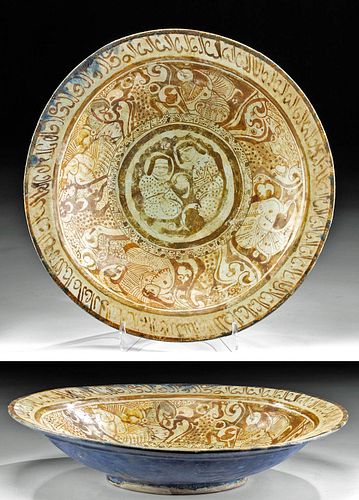Gorgeous 10th C. Islamic Nishapur Glazed Ceramic Plate
Lot 81
About Seller
Artemis Gallery
686 S Taylor Ave, Ste 106
Louisville, CO 80027
United States
Selling antiquities, ancient and ethnographic art online since 1993, Artemis Gallery specializes in Classical Antiquities (Egyptian, Greek, Roman, Near Eastern), Asian, Pre-Columbian, African / Tribal / Oceanographic art. Our extensive inventory includes pottery, stone, metal, wood, glass and textil...Read more
Categories
Estimate:
$3,500 - $5,000
Absentee vs Live bid
Two ways to bid:
- Leave a max absentee bid and the platform will bid on your behalf up to your maximum bid during the live auction.
- Bid live during the auction and your bids will be submitted real-time to the auctioneer.
Bid Increments
| Price | Bid Increment |
|---|---|
| $0 | $25 |
| $300 | $50 |
| $1,000 | $100 |
| $2,000 | $250 |
| $5,000 | $500 |
| $10,000 | $1,000 |
| $20,000 | $2,500 |
| $50,000 | $5,000 |
| $100,000 | $10,000 |
| $200,000 | $20,000 |
About Auction
By Artemis Gallery
Feb 13, 2020
Set Reminder
2020-02-13 10:00:00
2020-02-13 10:00:00
America/New_York
Bidsquare
Bidsquare : Exceptional Antiquities, Asian, Ethnographic
https://www.bidsquare.com/auctions/artemis-gallery/exceptional-antiquities-asian-ethnographic-4848
An important one-day auction featuring museum-worthy examples of Egyptian, Greek, Roman, Etruscan, Near Eastern, Far East / Asian, Pre-Columbian, African / Tribal, Oceanic, Native American, Spanish Colonial, Russian, Fossils, Ancient Jewelry, Fine Art, so much more! Artemis Gallery info@artemisgallery.com
An important one-day auction featuring museum-worthy examples of Egyptian, Greek, Roman, Etruscan, Near Eastern, Far East / Asian, Pre-Columbian, African / Tribal, Oceanic, Native American, Spanish Colonial, Russian, Fossils, Ancient Jewelry, Fine Art, so much more! Artemis Gallery info@artemisgallery.com
- Lot Description
Persia (Iran), Nishapur area, ca. late 10th century to early 13th century CE. A spectacular, large, glazed ceramic plate with a complex iconography done in a manganese-based pigment that has faded to a golden color over time. The broad rim features pseudo-Kufic script between two thin horizontal borders. Below that, on the sloping walls, is a thick band of stylized birds and swirling figures, giving the impression of many different textures of feathers coating the surface. In tondo are two kneeling, robed women. The exterior is a lovely cobalt blue. This is an impressive, large example of this distinctive ceramic style. Size: 14.05" W x 3.15" H (35.7 cm x 8 cm)
Nishapur was a center of politics and culture in medieval Persia, and its pottery is some of the most unique and beautiful we see from this time period. Its iconographically fascinating decorations are the result of technological innovation at the end of the 10th century. The body of this plate and others of its style is made of finely ground quartz mixed with clay; this created a white surface on which the artists could paint designs directly. The avian motifs are particularly interesting - they may represent Simurgh, an Iranian benevolent, mythical flying creature, but birds in general also had special meaning in Persia. For example, the one of the most famous pieces of literature from this period is The Conference of the Birds, written in 1177 by the poet Attar of Nishapur, which tells a story of birds gathering to decide who would be their king.
Provenance: private Vero Beach, Florida, USA collection, acquired in the late 1970s-early 1980s; ex-private old French collection
All items legal to buy/sell under U.S. Statute covering cultural patrimony Code 2600, CHAPTER 14, and are guaranteed to be as described or your money back.
A Certificate of Authenticity will accompany all winning bids.
We ship worldwide and handle all shipping in-house for your convenience.
#152101Expertly repaired and restored from three or four large pieces. Nice craquelure of the glaze. Motifs are well preserved with some small areas of overpaint.Condition
- Shipping Info
-
All shipping is handled in-house for your convenience. Your invoice from Artemis Gallery will include shipping calculation instructions. If in doubt, please inquire BEFORE bidding for estimated shipping costs for individual items.
-
- Buyer's Premium



 EUR
EUR CAD
CAD AUD
AUD GBP
GBP MXN
MXN HKD
HKD CNY
CNY MYR
MYR SEK
SEK SGD
SGD CHF
CHF THB
THB















